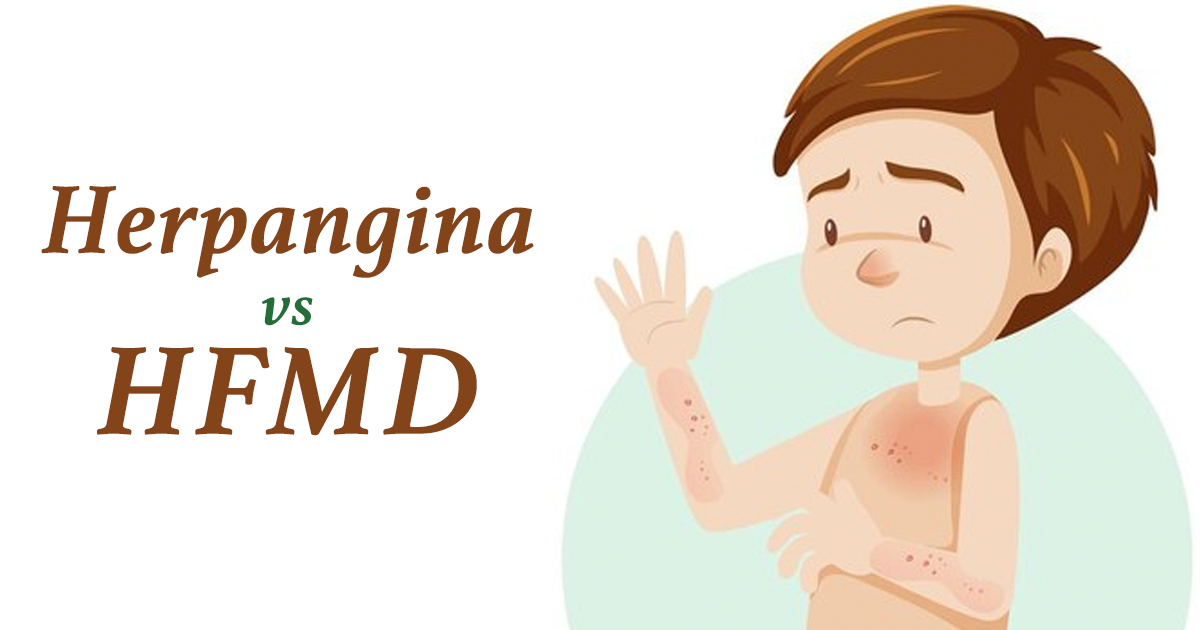Herpangina vs. HFMD: Spot the Difference, Treat the Symptoms

Herpangina and Hand, Foot, and Mouth Disease (HFMD) are viral infections that mostly affect children. Because they are both caused by enteroviruses and have similar symptoms, people often confuse them. However, they have key differences in where they appear on the body, how severe they are, and how they develop.
A study in the Journal of Medical Virology found that HFMD is more common than herpangina, with outbreaks happening mostly in summer and fall. The study also noted that HFMD cases are rising worldwide, especially in Asia, due to how easily the virus spreads. This makes it important to understand the differences between herpangina and HFMD for better treatment and prevention.
Herpangina: Symptoms and Causes
Herpangina is a viral infection characterized by painful ulcers or sores in the mouth and fever. It primarily affects children but can occasionally be seen in adults. The infection is most common in summer and early fall.
Herpangina is caused by a group of enteroviruses, most commonly:
- Coxsackievirus A (especially A1, A2, A3, A6, A10, and A16)
- Coxsackievirus B
- Echoviruses
The infection spreads through direct contact with respiratory secretions, saliva, stool, or contaminated surfaces.
Here are the symptoms of herpangina:
- Sudden high fever (up to 105°F or 40°C)
- Sore throat
- Painful ulcers on the back of the throat, soft palate, tonsils, and uvula
- Loss of appetite
- Fatigue and irritability
- Headache
Take note that herpangina does not cause a body-wide rash. Instead, it presents with isolated sores in the mouth, which are different from the skin rashes seen in HFMD.
Hand, Foot, and Mouth Disease: Causes and Symptoms
HFMD is another viral illness that is common in children under five but can also affect older children and adults. Unlike herpangina, HFMD is marked by a rash on the hands, feet, and mouth sores.
HFMD is primarily caused by:
- Coxsackievirus A16 (most common
- Enterovirus 71 (EV-71) (can cause severe complications)
- Other enteroviruses
Here are the symptoms of HFMD:
- Mild to moderate fever (usually lower than in herpangina)
- Painful mouth sores, similar to herpangina but often spreading to the tongue, gums, and inner cheeks
- Rash on hands, feet, buttocks, and sometimes arms and legs
- Skin blisters, which may be painful but are usually not itchy
- Loss of appetite
- General discomfort
Herpangina or HFMD? How to Tell Them Apart
Herpangina the same as hand foot mouth? The answer is no. While both are caused by enteroviruses and involve mouth sores, there are still differences between the two conditions.
Cause
Herpangina is caused by Coxsackievirus A, Coxsackievirus B, and Echoviruses, while HFMD is caused by Coxsackievirus A16, Enterovirus 71, and other enteroviruses.
Age Group Affected
Herpangina mainly affects children aged 3-10 years, whereas HFMD primarily affects infants and young children under 5 but can also impact older children and adults.
Fever Severity
Herpangina causes a higher fever, reaching up to 105°F, while HFMD usually results in a milder fever ranging from 99-102°F.
Mouth Lesions
Herpangina presents with painful ulcers on the soft palate, tonsils, and throat, whereas HFMD causes sores on the tongue, gums, and inner cheeks.
Skin Rash
Herpangina does not cause a rash, only mouth sores, while HFMD is characterized by a rash on the hands, feet, and sometimes the buttocks.
Duration
Herpangina typically lasts 5-7 days, whereas HFMD lasts slightly longer, around 7-10 days.
How Contagious Are Herpangina and HFMD?
Both herpangina and HFMD are highly contagious. They spread through direct contact with saliva, respiratory droplets, stool, or contaminated surfaces. Children in daycare and schools are most at risk due to close contact with infected peers.
Herpangina is contagious from 1-2 days before symptoms appear and up to 5-7 days after symptoms begin.
On the other hand, HFMD is most contagious during the first week but the virus can remain in stool for weeks after recovery, meaning children can still spread the infection even if they appear well.
How Herpangina and HFMD Are Diagnosed
Doctors diagnose both conditions based on:
- Physical examination (looking for mouth sores and rash)
- Medical history (recent exposure to infected individuals)
- Lab tests (in rare cases, throat swabs or stool samples may be analyzed)
How to Ease Symptoms of Herpangina and HFMD
Both herpangina and Hand Foot Mouth disease are viral infections, meaning antibiotics are ineffective. Treatment focuses on relieving symptoms.
Home Remedies and Symptom Management
- Encourage drinking plenty of fluids, but avoid acidic or spicy foods that may irritate the mouth.
- Acetaminophen (Tylenol) or ibuprofen (Advil) can help reduce fever and pain.
- Ice cream, yogurt, or cold drinks can soothe mouth pain.
- Washing hands frequently helps prevent the spread of the virus.
Medical Attention
Seek medical care if:
- Fever lasts longer than 3 days.
- Child shows signs of dehydration (dry mouth, reduced urination, lethargy).
- Severe throat pain makes swallowing difficult.
- Symptoms worsen instead of improving.
Recognizing Herpangina and HFMD Can Improve Health Outcomes
Knowing the difference between herpangina and HFMD helps parents stay calm and handle the illness better. Many worry when they see mouth sores or rashes, but these infections are usually mild and go away on their own. The real focus should be on stopping the spread, especially in schools and daycare centers. Good hygiene, early detection, and proper care matter more than panic.
